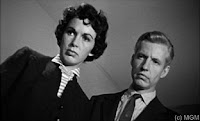Saturday, December 31, 2011
Friday, December 30, 2011
Thursday, December 29, 2011
Friday, December 23, 2011
Thursday, December 22, 2011
Tuesday, December 20, 2011
Wednesday, December 14, 2011
Tuesday, December 13, 2011
Monday, December 12, 2011
December 12: Kiss Me Deadly (1955 -- Robert Aldrich)
★★★★
The line on this movie is that it’s subversive, subverting noir, the Spillane character, and the Board of Censors. Even film credits. But it doesn’t seem subversive to me as much as hostile. The film seems to attack all these, stretching and deforming them. I don’t think Kiss Me Deadly is calling for a new form of film narrative; I think it’s slashing at the one it’s using. And its genre-bashing is a big part of what makes it worthwhile.
The Spillane character here is both inept and deplorable. Fifteen years before, Sam Spade didn’t mind tricking people or sometimes bullying them, but he’s an angel compared to Mike Hammer, who repeatedly bashes one man’s head into a building, bullies a weakling father into confession in front of his family, and crushes a coroner’s hand in a drawer and holds it there. This detective is exponentially more corrupt that Sam Spade , too. Private detective Sam makes his money by solving cases and thinks he can make a profit by recovering the Maltese falcon, but Hammer generally lives by getting a contract with a wife and having his partner, Velda, then seduce the husband to facilitate things. Even the secretarial sidekick is intensified in Kiss Me Deadly. Effie is the prim, loyal secretary to Sam, but Velda is a sexpot dressed in tight sweaters who’s regularly throwing herself at Hammer. It’s hard to imagine the faithful Effie slinking around a pole, sweating, and extending her legs toward Sam Spade, not to mention that we wouldn’t see Sam talking to her in bed while she’s recovering from a hangover. Kiss Me Deadly stretches and distorts the basic noir elements of detective and his girl.
There’s not much the film can do to exaggerate the typical noir shadows and low-angle shots, but Kiss Me Deadly amply appropriates them. And in an almost Expressionist gesture, the camera often takes the position of an interlocutor, and we find ourselves nose-to-nose with a grimace or seeing a fist heading our direction. These flourishes increase our self-consciousness about the film.
Kiss Me Deadly also amps up noir’s stakes. There may be some dark plot behind noir intrigue, but the end of Kiss Me Deadly becomes science fiction when the conspiracy leads Hammer to the sought-after box and we discover the box could actually end the world. Flesh is seared and buildings destroyed in this film as noir morphs into paranoid 50s sci fi at the end. This is no longer film noir.
There are many things to appreciate in this film. Many of the images are memorable and in-your-face, such as the one where Lily sits behind a stack of suitcases and we see only the suitcases with her feet sticking out from behind. And there are, in fact, numerous shots of shoes, feet and legs that the film uses to suggest entire characters (it’s not hard to image that Koreyoshi Kurahara found the trench coats and feet for his 1957 I Am Waiting in this film).
But as much as I like it, this film leaves me with a slight touch of disappointment. It shares the strange, twisted spirit of other mid-50s movies like Bigger than Life and Night of the Hunter, but Kiss Me Deadly gets quite close to parody if not actually crossing that line at times. Night of the Hunter cites German Expressionism very self-consciously, but it uses that vocabulary to talk about human experience and to touch the viewer; Kiss Me Deadly, though, seems more concerned with self-referentiality than with life, and as it deforms and intensifies noir, it doesn’t connect with me on much more than an intellectual level. It’s a very good film with many engaging flourishes, but I found it a little more interested in form than in the heart.
Thursday, December 8, 2011
Wednesday, December 7, 2011
Thursday, December 1, 2011
Subscribe to:
Posts (Atom)





